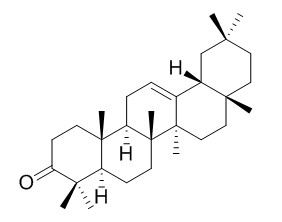beta-Amyrone
beta-Amyrone has antifungal activity, it also shows a moderate activity against Chikungunya virus replication (EC50 =86 uM). beta-Amyrone exhibits anti-α-glucosidase inhibitory activity and moderate anti- acetylcholinesterase (AChE) activity.
Inquire / Order:
manager@chemfaces.com
Technical Inquiries:
service@chemfaces.com
Tel:
+86-27-84237783
Fax:
+86-27-84254680
Address:
1 Building, No. 83, CheCheng Rd., Wuhan Economic and Technological Development Zone, Wuhan, Hubei 430056, PRC
Providing storage is as stated on the product vial and the vial is kept tightly sealed, the product can be stored for up to
24 months(2-8C).
Wherever possible, you should prepare and use solutions on the same day. However, if you need to make up stock solutions in advance, we recommend that you store the solution as aliquots in tightly sealed vials at -20C. Generally, these will be useable for up to two weeks. Before use, and prior to opening the vial we recommend that you allow your product to equilibrate to room temperature for at least 1 hour.
Need more advice on solubility, usage and handling? Please email to: service@chemfaces.com
The packaging of the product may have turned upside down during transportation, resulting in the natural compounds adhering to the neck or cap of the vial. take the vial out of its packaging and gently shake to let the compounds fall to the bottom of the vial. for liquid products, centrifuge at 200-500 RPM to gather the liquid at the bottom of the vial. try to avoid loss or contamination during handling.
APMIS.2019, 127(10):688-695
Eur Rev Med Pharmacol Sci.2020, 24(9):5127-5139.
JPC-Journal of Planar Chromatography2023, 36:179-190
J Nat Med.2017, 71(2):457-462
Journal of Natural Remedies2024, 24(3):555�C575.
Journal of Ginseng Research2022, j.jgr.2022.09.005.
Int J Mol Sci.2018, 19(9):E2825
Antioxidants.2022, 11(4), 67.
British Jou. Med.&Med. Research2014, 1802-1811
ACS Nano.2018, 12(4):3385-3396
Related and Featured Products
Fitoterapia. 2012 Sep;83(6):1076-80.
Chemical constituents of Anacolosa pervilleana and their antiviral activities.[Pubmed:
22613073]
In an effort to identify novel inhibitors of Chikungunya (CHIKV) and Dengue (DENV) virus replication, a systematic study with 820 ethyl acetate extracts of Madagascan plants was performed in a virus-cell-based assay for CHIKV and a DENV NS5 RNA-dependant RNA polymerase (RdRp) assay.
METHODS AND RESULTS:
The extract obtained from the leaves of Anacolosa pervilleana was selected for its significant activity in both assays. One new (E)-tridec-2-en-4-ynedioic acid named anacolosine (1), together with three known acetylenic acids, the octadeca-9,11,13-triynoic acid (2), (13E)-octadec-13-en-9,11-diynoic acid (3), (13E)-octadec-13-en-11-ynoic acid (4), two terpenoids, lupenone (5) and beta-Amyrone (6), and one cyanogenic glycoside, (S)-sambunigrin (7) were isolated. Their structures were elucidated by comprehensive analyses of NMR spectroscopy and mass spectrometry data. The inhibitory potency of these compounds was evaluated on CHIKV, DENV RdRp and West-Nile polymerase virus (WNV RdRp).
CONCLUSIONS:
Both terpenoids showed a moderate activity against CHIKV (EC(50) 77 and 86 μM, respectively) and the acetylenic acids produced IC(50) values around 3 μM in the DENV RdRp assay.
Phytochem. Lett., 2011, 4(1):34-7.
Chemical constituents of Drypetes gossweileri and their enzyme inhibitory and anti-fungal activities.[Reference:
WebLink]
Phytochemical studies on the methanolic extract of Drypetes gossweileri afforded N-β-d-glucopyranosyl-p-hydroxyphenylacetamide (1), p-hydroxyphenylacetic acid (2), p-hydroxyphenyl-acetonitrile (3), p-hydroxyacetophenone (4), 3,4,5-trimethoxyphenol (5), dolichandroside A (6), and beta-Amyrone(7).
METHODS AND RESULTS:
Compounds 1–7 were identified with the aid of extensive NMR and MS spectroscopic studies. Compound 1 was a new natural product and was isolated for the first time from plant containing N-glucose moiety incorporated in its structure. Compounds 1–7 exhibited moderate to the weak source anti-α-glucosidase inhibitory activity. Compound 7 exhibited moderate anti-acetylcholinesterase (AChE) activity while the rest of the isolates were weakly active in this bioassay. Compounds 1–7 also showed moderate anti-fungal activity.Graphical abstractFrom the methanolic extract of Drypetes gossweileri, one new natural product, N-β-d-glucopyranosyl-p-hydroxyphenylacetamide (1), along with six known natural products, p-hydroxyphenylacetic acid (2), p-hydroxyphenylacetonitrile (3), p-hydroxyacetophenone (4), 3,4,5-trimethoxyphenol (5), dolichandroside A (6), and beta-Amyrone (7) were isolated. All of the isolates exhibited different levels of anti-α-glucosidase, anti-acetylcholinesterase and anti-fungal activities.Research highlightsChemical investigation of Drypetes gossweileri afforded one new natural product, N-β-d-glucopyranosyl-p-hydroxyphenylacetamide (1), along with six known natural products.
CONCLUSIONS:
All of the isolates exhibited different levels of anti-α-glucosidase, anti-acetylcholinesterase and anti-fungal activities.
PLoS Negl Trop Dis. 2015 Mar; 9(3): e0003488.
The In Vitro Antifungal Activity of Sudanese Medicinal Plants against Madurella mycetomatis, the Eumycetoma Major Causative Agent.[Pubmed:
25768115]
Eumycetoma is a debilitating chronic inflammatory fungal infection that exists worldwide but it is endemic in many tropical and subtropical regions. The major causative organism is the fungus Madurella mycetomatis. The current treatment of eumycetoma is suboptimal and characterized by low cure rate and high recurrence rates. Hence, an alternative therapy is needed to address this.
METHODS AND RESULTS:
Here we determined the antifungal activity of seven Sudanese medicinal plant species against Madurella mycetomatis. Of these, only three species; Boswellia papyrifera, Acacia nubica and Nigella sativa, showed some antifungal activity against M. mycetomatis and were further studied. Crude methanol, hexane and defatted methanol extracts of these species were tested for their antifungal activity. B. papyrifera had the highest antifungal activity (MIC50 of 1 ug/ml) and it was further fractionated. The crude methanol and the soluble ethyl acetate fractions of B. papyrifera showed some antifungal activity. The Gas-Liquid-Chromatography hybrid Mass-Spectrophotometer analysis of these two fractions showed the existence of beta-amyrin, beta-Amyrone, beta-Sitosterol and stigmatriene. Stigmatriene had the best antifungal activity, compared to other three phytoconstituents, with an MIC-50 of 32 μg/ml.
CONCLUSIONS:
Although the antifungal activity of the identified phytoconstituents was only limited, the antifungal activity of the complete extracts is more promising, indicating synergism. Furthermore these plant extracts are also known to have anti-inflammatory activity and can stimulate wound-healing; characteristics which might also be of great value in the development of novel therapeutic drugs for this chronic inflammatory disease. Therefore further exploration of these plant species in the treatment of mycetoma is encouraging.



